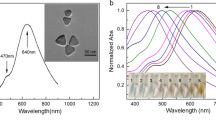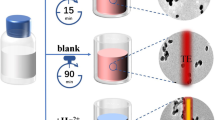Abstract
A triangular gold nanoplate (AuNPL)–based colorimetric assay is presented for ultrasensitive determination of cupric ions (Cu2+) and mercuric ions (Hg2+) in sequence. AuNPLs were found to be etched efficiently when producing triiodide ions (I3−) by a redox reaction between Cu2+ and iodide ions (I−), leading to a change of the shape of AuNPLs from triangular to sphere along with a color change from blue to pink. In the presence of Hg2+ the etching of AuNPLs was suppressed due to the consumption of I− by the formation of HgI2. With an increase of the concentration of the Hg2+ a transformation from sphere to triangular in the shape of AuNPLs occurred with a color change from pink to blue. The evolution of AuNPLs from etching to anti-etching state by sequential addition of Cu2+ and Hg2+ was accompanied with color variations and band shifts of localized surface plasmon resonance (LSPR), allowing for visual and spectroscopic determination of Cu2+ and Hg2+ successively within 15 min. In the range 0.01–1.5 μM for Cu2+ and 0.02–3.0 μM for Hg2+, the linear relationship between the band shift values and the target ions concentration was found good (R2 > 0.996). The limit of detections (3S/k) was 19 nM for Cu2+ and 9 nM for Hg2+, respectively. The lowest visual estimation concentration was 80 nM for both Cu2+ and Hg2+ through the distinguishable color changes. This system exhibited desirable selectivity for Cu2+ and Hg2+ over other common ions tested. The method has been successfully applied to sequential determination of Cu2+ and Hg2+ in real water and food samples.

Scheme 1 Schematic illustration for sequential detection of Cu2+ and Hg2+ based on etching of AuNPLs






Similar content being viewed by others
References
Tang LJ, Yu HL, Zhong KL, Gao X, Li JR (2019) An aggregation-induced emission-based fluorescence turn-on probe for Hg2+ and its application to detect Hg2+ in food samples. RSC Adv 9:23316–23323
Lim JW, Kim T-Y, Choi S-W, Woo M-A (2019) 3D-printed rolling circle amplification chip for on-site colorimetric detection of inorganic mercury in drinking water. Food Chem 300:125177–125184
Yao S, Zhang G, Song J, Liu T, Yang M, Yu J, Yang X, Tian Y, Zhang X, Zhou H (2018) Exploration the effect of structural adjustment on identifying medium and bio-targeting based on two similar coumarin compounds. Sensors Actuators B Chem 272:574–581
Li L, Zhang LP, Zhao Y, Chen ZB (2018) Colorimetric detection of Hg (II) by measurement the color alterations from the “before” and “after” RGB images of etched triangular silver nanoplates. Microchim Acta 185:235–240
Schmite BdFP, Bitobrovec A, Hacke ACM, Pereira RP, Weinert PL, dos Anjos VE (2019) In vitro bioaccessibility of Al, Cu, Cd, and Pb following simulated gastro-intestinal digestion and total content of these metals in different Brazilian brands of yerba mate tea. Food Chem 281:285–293
Mohammadi A, Khalili B, Haghayegh AS (2019) A novel chromone based colorimetric sensor for highly selective detection of copper ions: synthesis, optical properties and DFT calculations. Spectrochim Acta Part A 222:117193–117200
Zhao L, Guan X, Yu B, Ding N, Liu X, Ma Q, Yang S, Yilihamu A, Yang S-T (2019) Carboxylated graphene oxide-chitosan spheres immobilize Cu2+ in soil and reduce its bioaccumulation in wheat plants. Environ Int 133:105208–105217
Boente C, Albuquerque MTD, Gerassis S, Rodríguez-Valdés E, Gallego JR (2019) A coupled multivariate statistics, geostatistical and machine-learning approach to address soil pollution in a prototypical Hg-mining site in a natural reserve. Chemosphere 218:767–777
Wang Z, Wang H, Wang H, Li Q, Li Y (2019) Heavy metal pollution and potential health risks of commercially available Chinese herbal medicines. Sci Total Environ 653:748–757
Shen X, Zhang H, He X, Shi H, Stephan C, Jiang H, Wan C, Eichholz T (2019) Evaluating the treatment effectiveness of copper-based algaecides on toxic algae Microcystis aeruginosa using single cell-inductively coupled plasma-mass spectrometry. Anal Bioanal Chem 411:5531–5543
Chen S, Yan J, Li J, Lu D (2019) Dispersive micro-solid phase extraction using magnetic ZnFe2O4 nanotubes as adsorbent for preconcentration of Co (II), Ni (II), Mn (II) and Cd (II) followed by ICP-MS determination. Microchem J 147:232–238
Qiu YX, Li J, Li HB, Zhao Q, Wang HM, Fang HL, Fan DH, Wang W (2015) A facile and ultrasensitive photoelectrochemical sensor for copper ions using in-situ electrodeposition of cuprous oxide. Sensors Actuators B Chem 208:485–490
Huang Y, Peng J, Huang X (2019) Allylthiourea functionalized magnetic adsorbent for the extraction of cadmium, copper and lead ions prior to their determination by atomic absorption spectrometry. Microchim Acta 186:51–58
Mao A, Wei C (2019) Cytosine-rich ssDNA-templated fluorescent silver and copper/silver nanoclusters: optical properties and sensitive detection for mercury (II). Microchim Acta 186:541–548
Xiong H, Wang B, Wen W, Zhang X, Wang S (2019) Fluorometric determination of copper (II) by using 3-aminophenylboronic acid-functionalized CdTe quantum dot probes. Microchim Acta 186:392–398
Zarlaida F, Adlim M (2017) Gold and silver nanoparticles and indicator dyes as active agents in colorimetric spot and strip tests for mercury (II) ions: a review. Microchim Acta 184:1–14
Zeng J, Cao Y, Lu C-H, Wang X-d, Wang Q, Wen C-y, Qu J-B, Yuan C, Yan Z-f, Chen X (2015) A colorimetric assay for measuring iodide using Au@Ag core–shell nanoparticles coupled with Cu2+. Anal Chim Acta 891:269–276
Li J, Tu W, Li H, Han M, Lan Y, Dai Z, Bao J (2013) In situ-generated nano-gold plasmon-enhanced photoelectrochemical aptasensing based on carboxylated perylene-functionalized graphene. Anal Chem 86:1306–1312
Zhu R, Song J, Zhou Y, Lei P, Li Z, Li H-W, Shuang S, Dong C (2019) Dual sensing reporter system of assembled gold nanoparticles toward the sequential colorimetric detection of adenosine and Cr (III). Talanta 204:294–303
Zhou Y, Hui D, Liu L, Li M, Xiao K, Xu M (2014) Selective and sensitive colorimetric sensor of mercury (II) based on gold nanoparticles and 4-mercaptophenylboronic acid. Sensors Actuators B Chem 196:106–111
Mehta VN, Basu H, Singhal RK, Kailasa SK (2015) Simple and sensitive colorimetric sensing of Cd2+ ion using chitosan dithiocarbamate functionalized gold nanoparticles as a probe. Sensors Actuators B Chem 220:850–858
Yao C, Chen S, Wang L, Deng H, Tong S (2019) Low cost and rapid fabrication of copper sulfides nanoparticles for selective and efficient capture of noble metal ions. Chem Eng J 373:1168–1178
Li T, Bi J, Ren H, Ling R, Zhang C, Wu Z, Qin W, Jiao P (2019) A gold nanorod-based plasmonic platform for multi-logic operation and detection. Nanotechnology 30:55503–55511
Li L, Yu L, Yan Z, Chen Z (2018) Target binding and DNA hybridization-induced gold nanoparticle aggregation for colorimetric detection of thrombin. Sensors Actuators B Chem 262:733–738
Najafzadeh F, Ghasemi F, Hormozi-Nezhad MR (2018) Anti-aggregation of gold nanoparticles for metal ion discrimination: a promising strategy to design colorimetric sensor arrays. Sensors Actuators B Chem 270:545–551
Liu R, Wang Z, Chen Z (2013) Colorimetric sensing of copper (II) based on catalytic etching of gold nanorods. RSC Adv 3:13318–13323
Liu JM, Jiao L, Lin LP, Cui ML, Wang XX, Zhang LH, Zheng ZY, Jiang SL (2013) Non-aggregation based label free colorimetric sensor for the detection of Cu2+ based on catalyzing etching of gold nanorods by dissolve oxygen. Talanta 117:425–430
Karami P, Khoshsafar H, Johari-Ahar M, Arduini F, Afkhami A, Bagheri H (2019) Colorimetric immunosensor for determination of prostate specific antigen using surface plasmon resonance band of colloidal triangular shape gold nanoparticles. Spectrochim Acta Part A 222:117218–117225
Tangeysh B, Moore Tibbetts K, Odhner JH, Wayland BB, Levis RJ (2015) Triangular gold nanoplate growth by oriented attachment of Au seeds generated by strong field laser reduction. Nano Lett 15:3377–3382
Chen L, Ji F, Xu Y, He L, Mi Y, Bao F, Sun B, Zhang X, Zhang Q (2014) High-yield seedless synthesis of triangular gold nanoplates through oxidative etching. Nano Lett 14:7201–7206
Zhang Z, Chen Z, Cheng F, Zhang Y, Chen L (2016) Iodine-mediated etching of gold nanorods for plasmonic sensing of dissolved oxygen and salt iodine. Analyst 141:2955–2961
Peng R, He H, Wang Q, Yan X, Yu Q, Qin H, Lei Y, Luo L, Feng Y (2018) Cu (II) triggering redox-regulated anti-aggregation of gold nanoparticles for ultrasensitive visual sensing of iodide. Anal Chim Acta 1036:147–152
Zhang Z, Chen Z, Wang S, Cheng F, Chen L (2015) Iodine-mediated etching of gold nanorods for plasmonic ELISA based on colorimetric detection of alkaline phosphatase. ACS Appl Mater Interfaces 7:27639–27654
Wang R, Wang W, Ren H, Chae J (2014) Detection of copper ions in drinking water using the competitive adsorption of proteins. Biosens Bioelectron 57:179–185
Liu S, Li X (2016) Colorimetric detection of copper ions using gold nanorods in aquatic environment. Mater Sci Eng B 240:49–54
Zhang C, Lu LQ, Deng P, Tian XK, Liu MY, Li AM (2016) Synthesis of 3,4-diaminobenzenethiol and its application in gold nanoparticle-based colorimetric determination of copper ions. RSC Adv 107:105119–105124
Abedalwafa MA, Yan L, Li D, Sanbhal N, Yang J, Lu W (2018) Aminated polyacrylonitrile nanofibers with immobilized gold-silver core-shell nanoparticles for use in a colorimetric test strip for copper (II). Microchim Acta 185:402–411
Deymehkar E, Taher MA, Karami C, Arman A (2017) Synthesis of SPR nanosensor using gold nanoparticles and its application to copper (II) determination. Silicon 10:1–8
Ye Y, Lv M, Zhang X, Zhang Y (2015) Colorimetric determination of copper (II) ions using gold nanoparticles as a probe. RSC Adv 5:1002311–1102317
Kataria R, Sethuraman K, Vashisht D, Vashisht A, Mehta SK, Gupta A (2019) Colorimetric detection of mercury ions based on anti-aggregation of gold nanoparticles using 3, 5-dimethyl-1-thiocarboxamidepyrazole. Microchem J 148:299–305
Kumar VV, Anthony SP (2016) Highly selective colorimetric sensing of Hg2+ ions by label free AuNPs in aqueous medium across wide pH range. Sensors Actuators B Chem 225:413–419
Song X, Wang Y, Liu S, Zhang X, Wang H, Wang J, Huang J (2019) Colorimetric and visual mercury (II) assay based on target-induced cyclic enzymatic amplification, thymine-Hg (II)-thymine interaction, and aggregation of gold nanoparticles. Microchim Acta 186:105–111
Li W, Li Y, Qian HL, Zhao X, Yang C-X, Yan XP (2019) Fabrication of a covalent organic framework and its gold nanoparticle hybrids as stable mimetic peroxidase for sensitive and selective colorimetric detection of mercury in water samples. Talanta 204:224–228
Wang Q, Li Y, Li M, Wen C, Liu R, Subhan F, Yan Z, Zeng J (2015) A colorimetric approach for measuring mercuric ions with high selectivity using label-free gold nanoparticles and thiourea. Anal Methods 7:6837–6841
Funding
This work was financially supported by National Natural Science Foundation of China (Nos. 21974085, 61971274) and the Key Laboratory of Analytical Chemistry for Biology and Medicine of Ministry of Education in Wuhan University (ACBM2014002).
Author information
Authors and Affiliations
Corresponding authors
Ethics declarations
Conflict of interest
The authors declare that they have no conflicts of interest.
Additional information
Publisher’s note
Springer Nature remains neutral with regard to jurisdictional claims in published maps and institutional affiliations.
Electronic supplementary material
ESM 1
(DOCX 171 kb)
Rights and permissions
About this article
Cite this article
Wang, Q., Peng, R., Wang, Y. et al. Sequential colorimetric sensing of cupric and mercuric ions by regulating the etching process of triangular gold nanoplates. Microchim Acta 187, 205 (2020). https://doi.org/10.1007/s00604-020-4176-0
Received:
Accepted:
Published:
DOI: https://doi.org/10.1007/s00604-020-4176-0




